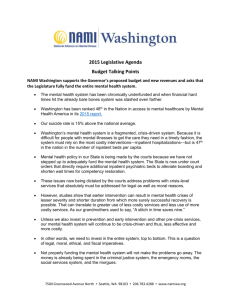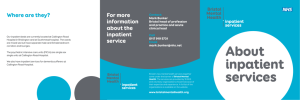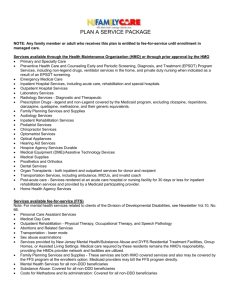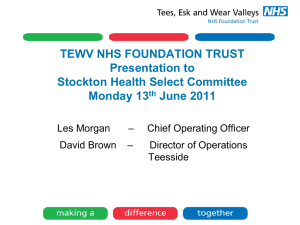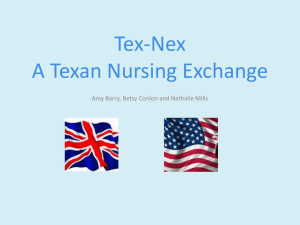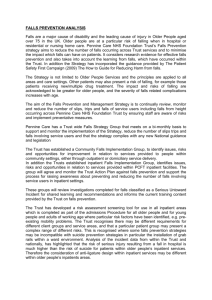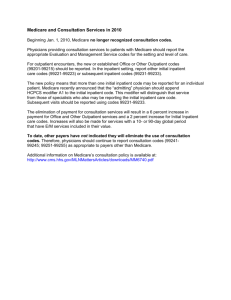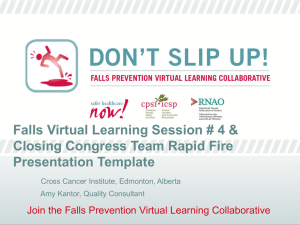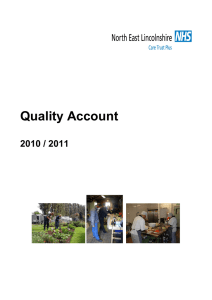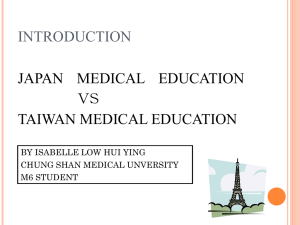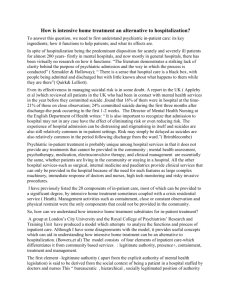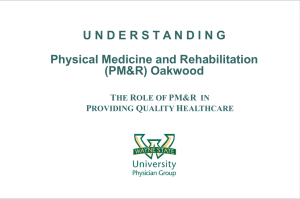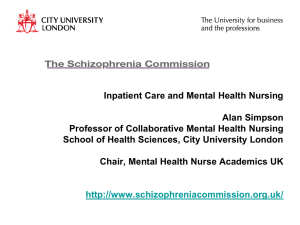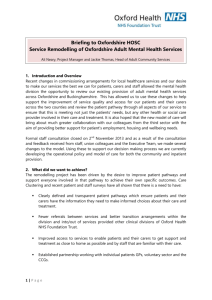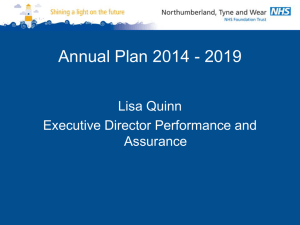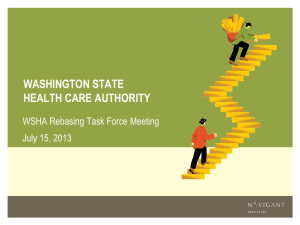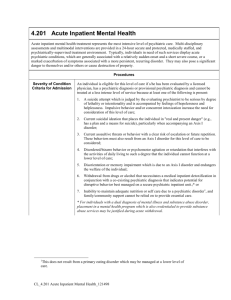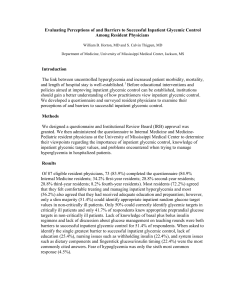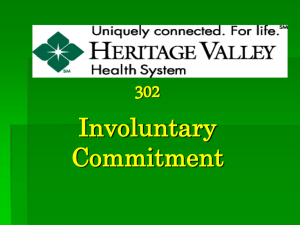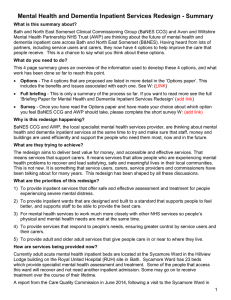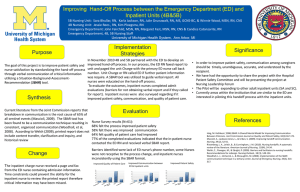April 2014 - Northumberland, Tyne and Wear NHS Trust
advertisement
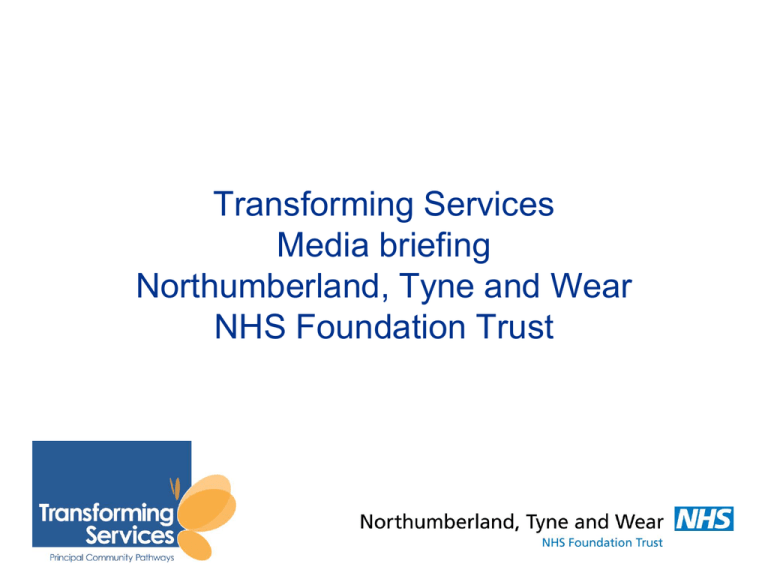
Transforming Services Media briefing Northumberland, Tyne and Wear NHS Foundation Trust Strategic Direction The environment in which we work: • Quality Sustainability • • • Cost We have to improve quality for the patient We have to reduce our overall cost of doing so We aim to improve clinical effectiveness thus reducing reliance on inpatient beds We have to create sustainable services, delivered by sustainable organisations, operating in a sustainable system What our partners have told us: • • • • We have to get much better at what we do and how we do it We have to get better at listening and acting on what people are telling us We have to be consistently good across all our services We need to get the patient quickly into the right services and then deliver the best outcome possible What patients and carers have told us: • • Patient • • • They want high-quality, safe care close to home They want inpatient services to be of a high standard They want services designed and operated around the needs of patients They want the patient to be truly ‘at the centre’ They want to gain and re-gain independence, as far as possible The Service Model Request for Help Information & Advice Initial Response Initial evaluation regarding nature, risk, complexity and urgency of the problem More Intensive Packages of Care Hospital Signposting to principal service pathway for assessment and formulation Psychiatric Intensive Care Treatment Intensity Low Security Specialist Ward Crisis Beds PICU Environment Acute Ward Intermediate beds In the Community Low Security Intermediate Facility Challenging Crisis Bed Behaviour Acute Ward Mild severe non psychotic Very severe & complex nonpsychotic Psychosis Dementia Assessment Intensive Home Treatment At Home Intensive Home Home Etc. Challenging Behaviour Treatment Assessment Formulation & Treatment Planning Crisis Assessment Discharge Neuro disability Learning Disability Children & Young People Substance Misuse Scaffolding Medium Security Service Model Review Principles • • • • • You should reach us, quickly and simply The earlier the better To get the right help and care, safely and easily From our flexible and skilled workforce In collaboration with you and your carers and partnership organisations • So that you can gain / re-gain independence, as far as possible • By making smooth and sustainable steps forward • Reaching us again, simply and quickly Urgent Care - Initial Response Team Universal Crisis Team Initial Response Team Rapid Response Nurses REQUEST FOR HELP Info Collection & routing Triage & Action Home Based Treatment Flexible Working Assessment Gatekeeping ADVICE AND SCAFFOLDING Community Care / Specialist Care ROUTING You should reach us, quickly and simply. The earlier the better The need to realign and balance resources: At any time, 3% of patients are consuming 52% of resources • • Inpatient Services Community Services £92.2M £84.8M NTW Whole costs NTW Whole costs • • We spend in inpatient areas to the detriment of community services A few patients consume much of the resource Many inpatients perhaps don’t need to be, but we lack the necessary community services to support them out of hospital We need to balance resources to maximise quality over cost Principal Community Pathways (PCP) Principal Community Pathways A programme to design and implement new, evidence-based community pathways for adults and older people. Our ambition is high and is matched by the expectations of service users and carers. The new pathways will: • Significantly improve quality for the patient • Double current productive time of community services by redesigning current systems and reducing bureaucracy • Enhance the skills of our workforce • Improve ways of working and interfaces with partners • Reduce reliance on inpatient beds and enable cost savings This is not achievable in isolation and to be successful we need it to be part of integrated work with partners What will be different? • • • • • • • Current Experience There are lots of confusing ways to access services Most non urgent services operate Monday to Friday 9 – 5, and there are waiting lists Treatment episodes cannot always be linked to an outcome or a nice guidance recommended treatment, staff often have to refer to others for treatment Patients can bounce around the system Staff time is taken up with typing, driving and admin Patients stay in services for a long time due to lack of joined up working and support to help them recover Patients don’t want to be discharged because it’s hard to get back into services • • • • • • • Our Commitment There will be a single point of access for all referrals Most non urgent services will work from 8am – 8pm, and waiting lists will be minimal Treatment packages will be evidence based and staff will be trained to deliver a broader range of nice recommended interventions Principle of ‘no Bouncing’ Staff will have twice as much time to spend with patients Services will have a recovery focus from day 1. Integrated working will improve the quality of life for service users. Service users will be able to re access services easily and quickly if they need to. What does this mean for inpatient services? Our aim for in-patient services is to ensure that when service users need to be in hospital, they are looked after in • an appropriate environment, • which is properly staffed, and • delivers effective interventions which are focussed on recovery • supporting people to step down out of hospital, as soon as their needs allow What does this mean for inpatient services • Currently the Trust uses less beds than it has available and we have ‘spare capacity’ • The amount of ‘spare capacity’ is expected to increase as significant improvements are made to community services • So, overall across the Trust we are looking to reduce inpatient provision for adults and older people’s services • Any major changes will be subject to public involvement and consultation in partnership with our Clinical Commissioning Groups The travel issue… • Across NTW it is not unusual for people to travel to the right inpatient services. • Every patient is asked about travel for them and their carers/family on admission • Wards have a number of resources available to help families and patients, including ward cars, access to information etc. • We are working on ways to ensure local staff can keep in touch without too much travel
